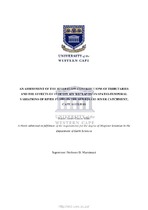| dc.contributor.advisor | Mazvimavi, Dominic | |
| dc.contributor.author | Mehl, Daniel James Gustav | |
| dc.date.accessioned | 2019-09-30T13:31:32Z | |
| dc.date.available | 2019-09-30T13:31:32Z | |
| dc.date.issued | 2019 | |
| dc.identifier.uri | http://hdl.handle.net/11394/7031 | |
| dc.description | >Magister Scientiae - MSc | en_US |
| dc.description.abstract | Improved knowledge is required on the quantity and source of water resources, particularly evident during periods of drought currently being faced in South Africa. There is inadequate knowledge with regards to the flood attenuating properties of wetlands, particularly evident in the ungauged catchments of Southern Africa. This study aims to improve the knowledge on the contribution of flow from tributaries with headwaters in mountainous regions to low lying areas and the effects of wetlands on river flow patterns. Several river flow monitoring sites were established along the major upper tributaries of the Nuwejaars River at which daily water levels were recorded and bi-weekly discharge measurements were conducted. Weather data was collected using four automatic weather stations and three automatic rain gauges’ setup throughout the catchment. Rainfall data coupled with rating curves and daily discharges were used to assess the flow responses of these tributaries to rainfall events. Additionally, stable isotope analysis and basic water quality analysis was used to determine the major sources of flow within the major tributaries. The rainfall and river flow data collected, coupled with the characterization of the wetland was used to determine the flood attenuation capabilities of the wetland. Lastly, a conceptual model based on a basic water balance was developed to further explain the role of the wetland and its effects on river flows. The results showed a 27-hour lag time in peak flows from the upper tributaries at the inflows of the wetland to the outflow. Two of the upper tributaries had flow throughout the year and were fed by springs in the upper mountainous regions of the catchment and all tributaries were largely reliant on rainfall for peak flows. The temporary storage of flows within the wetland occurred as a result of the Nuwejaars River bursting its banks, filling of pools, or ponds and the Voëlvlei Lake. It was concluded that the wetland increased the travel time and decreased the magnitude of flows of the Nuwejaars River. However, due to the fact that wetlands are interlinked on a catchment scale and have a collective effect on flood attenuation this study may be improved by looking at the wetlands within the catchment holistically. | en_US |
| dc.language.iso | en | en_US |
| dc.publisher | University of the Western Cape | en_US |
| dc.subject | Heuningnes Catchment | en_US |
| dc.subject | Flood prediction | en_US |
| dc.subject | Ungauged catchments | en_US |
| dc.subject | Wetland classification | en_US |
| dc.title | An assessment of the river flow contributions of tributaries and the effects of floodplain wetlands on spatio-temporal variations of river flows in the Nuwejaars river catchment, Cape Agulhas | en_US |
| dc.rights.holder | University of the Western Cape | en_US |

